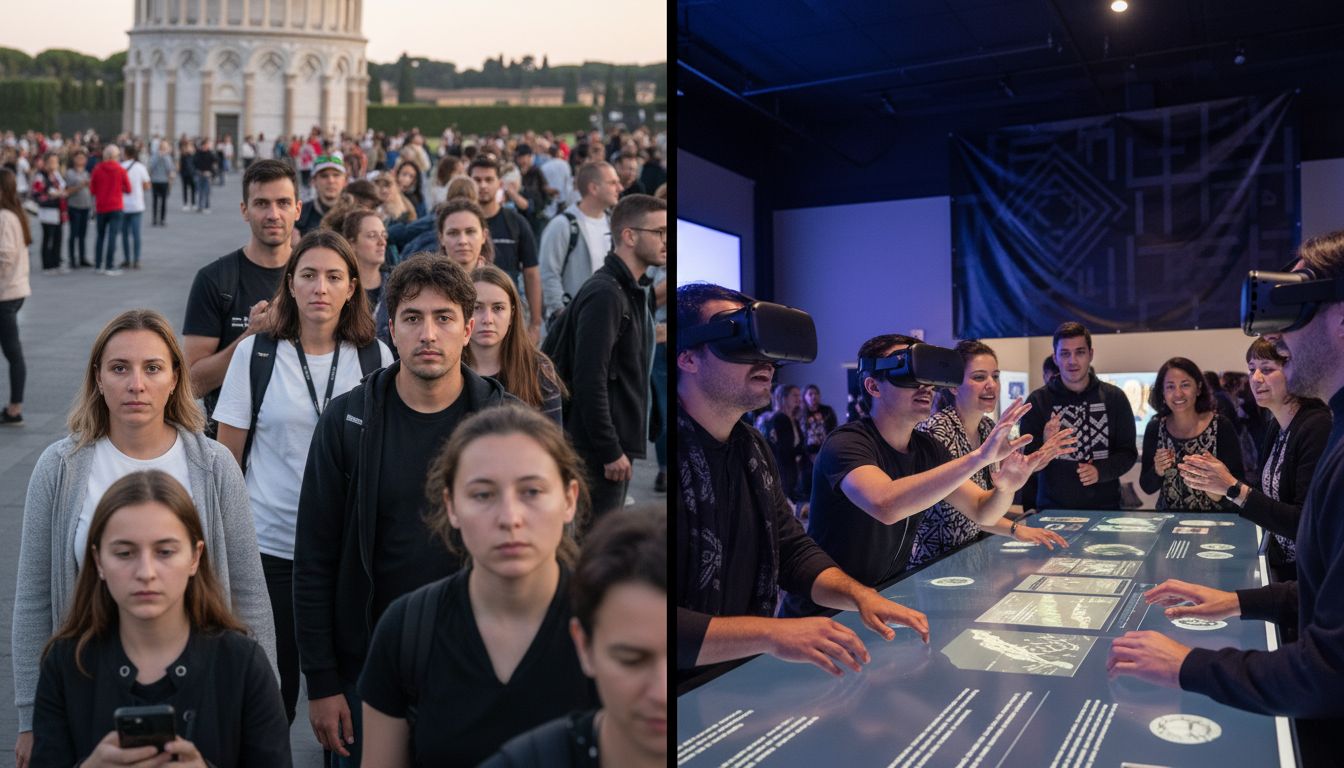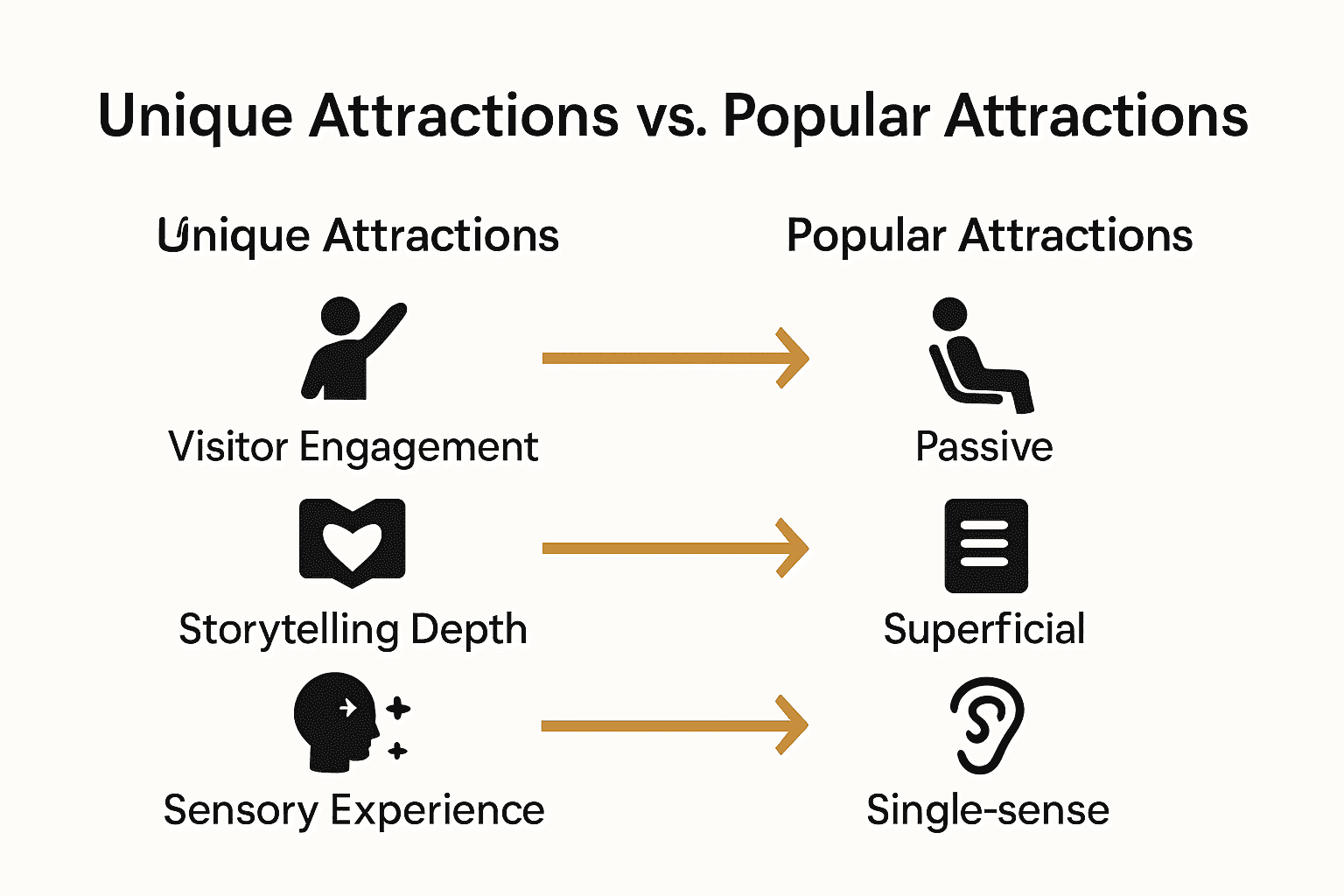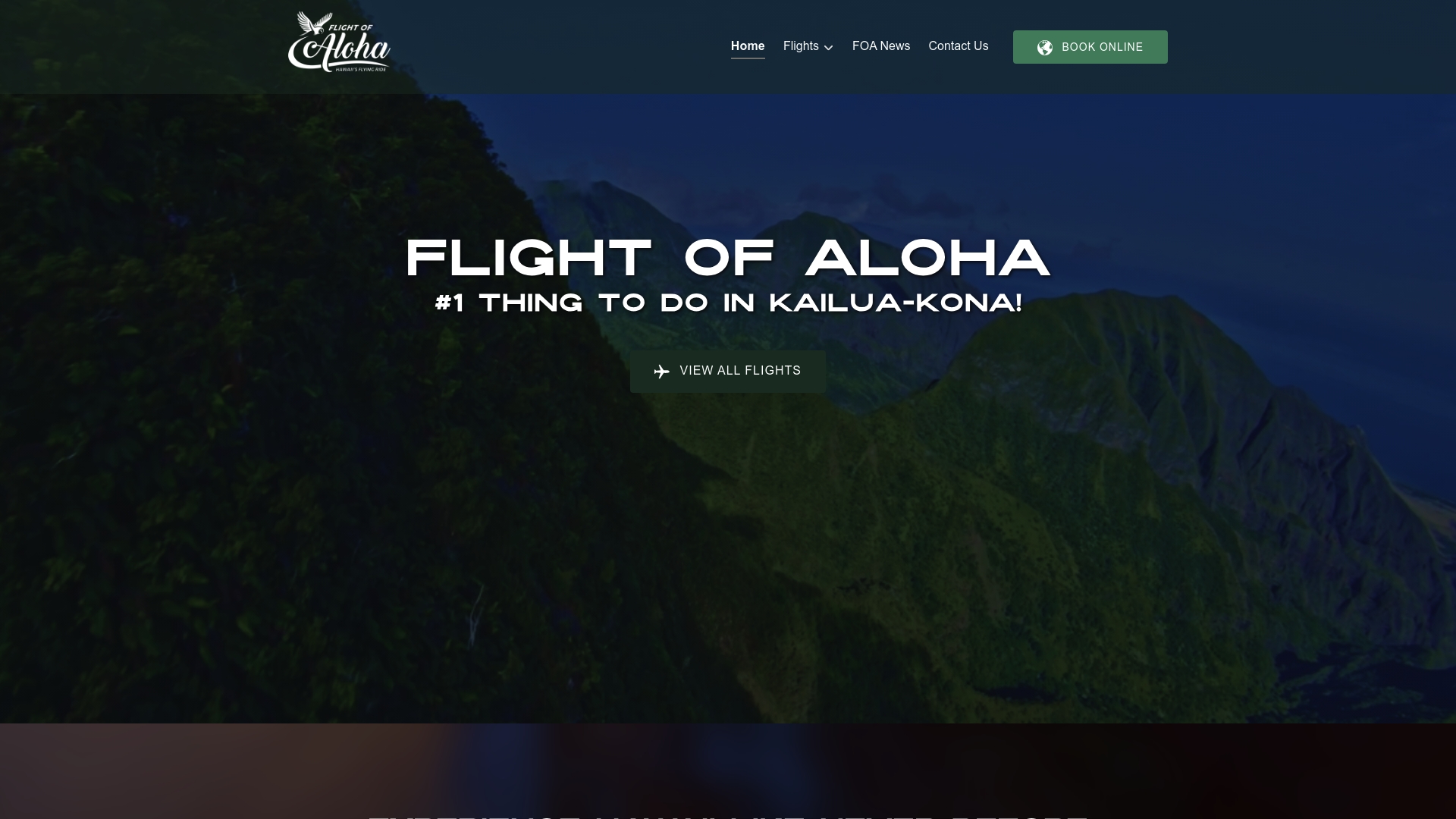What Makes a Unique Attraction: Complete Guide

More than 60 percent of travelers say they remember experiences, not just sights, long after a trip ends. This difference is what sets a truly unique attraction apart from the rest. In a world full of typical tourist stops, finding an experience that feels fresh, immersive, and deeply personal can leave a real mark. Discover what makes certain attractions unforgettable and how they turn simple visits into stories worth sharing.
Table of Contents
- Defining a Unique Attraction Experience
- Types and Key Elements of Unique Attractions
- Innovative Technologies and Senses Engaged
- Cultural Storytelling and Local Identity
- Comparing Unique Attractions to Popular Alternatives
Key Takeaways
| Point | Details |
|---|---|
| Unique Experiences Optimize Engagement | Unique attractions create meaningful, interactive experiences, engaging visitors beyond mere observation. |
| Cultural Storytelling Enhances Connections | Integrating authentic local narratives fosters deeper emotional bonds between visitors and host communities. |
| Innovative Technologies Transform Visits | Utilizing advanced technologies like VR and AR enhances multisensory engagement, offering dynamic and personalized experiences. |
| Authenticity is Key to Distinction | Unique attractions emphasize genuine representation and rich cultural contexts, setting them apart from typical tourist destinations. |
Defining a Unique Attraction Experience
A unique attraction experience transcends typical tourist encounters by offering something truly extraordinary – an immersive journey that captures visitors’ imagination and creates lasting memories. According to research from ajhtl.com, the core of a distinctive attraction lies in its ability to showcase exceptional physical or cultural resources while maintaining profound visitor engagement.
The foundational elements of a unique attraction experience include several critical components:
- Distinctive Resource: A striking, one-of-a-kind element that sets the experience apart from generic offerings
- Visitor Engagement: Interactive components that stimulate imagination and emotional connection
- Contextual Integrity: Preserving the authenticity and original character of the attraction
- Sensory Stimulation: Multisensory elements that create a rich, memorable encounter
Research from uwstout.edu further illuminates that truly exceptional attractions go beyond mere visual spectacle. They craft an environment that excites public imagination, transforming a simple visit into a transformative journey. For visitors seeking more than passive observation, experiential tourism guide offers deeper insights into creating meaningful travel moments.
The magic of a unique attraction lies not just in what visitors see, but in how deeply they can connect with the experience. It’s about creating a narrative that resonates, an encounter that lingers in memory long after the visit concludes – turning a simple attraction into an unforgettable story waiting to be told.
Types and Key Elements of Unique Attractions
Understanding the diverse landscape of unique attractions requires a nuanced exploration of their fundamental categories and distinguishing characteristics. According to research from iki.bas.bg, tourist attractions can be comprehensively classified into four pivotal types that shape visitor experiences:
- Natural Environment Attractions: Locations with inherent scenic beauty or ecological significance
- Unintentional Attractions: Spaces not originally designed for tourism but compelling to visitors
- Purpose-Built Attractions: Intentionally created destinations specifically to draw travelers
- Event-Based Attractions: Temporary or recurring experiences that generate unique engagement
The location-based attractions guide further illuminates how these categories intersect with visitor expectations. Research from ajhtl.com expands on this framework by distinguishing between natural and man-made attractions, highlighting that each type possesses distinctive features crucial to creating memorable experiences.
Key elements that transform an ordinary attraction into an extraordinary encounter include authenticity, interactivity, and emotional resonance. Whether it’s a breathtaking landscape, an immersive cultural experience, or a technologically innovative exhibit, unique attractions share a common thread: they transcend passive observation, inviting visitors to become active participants in a narrative larger than themselves. These attractions don’t just showcase a location or experience – they tell a story, evoke emotions, and create connections that linger long after the visit concludes.

Innovative Technologies and Senses Engaged
Immersive technologies are revolutionizing attraction experiences, transforming passive observation into multisensory journeys that captivate and engage visitors on unprecedented levels. According to research from bestonamusementrides.ru, cutting-edge technologies like virtual reality (VR), augmented reality (AR), and interactive projections are redefining how attractions stimulate human perception and emotional response.
The sensory landscape of modern attractions now encompasses multiple dimensions of engagement:
- Visual Immersion: High-resolution displays and 360-degree projection mapping
- Auditory Stimulation: Spatial sound technologies that create precise acoustic environments
- Tactile Interaction: Motion platforms and haptic feedback systems
- Olfactory Experiences: Scent generation technologies that trigger memory and emotion
- Kinesthetic Engagement: Interactive elements that respond to visitor movement
These technological innovations go far beyond traditional entertainment models. Why Choose Indoor Attractions highlights how sophisticated sensory technologies can create controlled, consistently remarkable experiences that transcend physical limitations. By leveraging sophisticated sensor technologies and adaptive algorithms, modern attractions can craft personalized journeys that respond dynamically to individual visitor interactions.
The future of unique attractions lies in their ability to blur the boundaries between reality and imagination. These experiences are no longer about passive consumption but active participation – inviting visitors to become co-creators of their own memorable narratives through seamlessly integrated technological interfaces that engage the full spectrum of human sensory perception.
Cultural Storytelling and Local Identity
Cultural storytelling transforms attractions from mere physical spaces into living, breathing narratives that connect visitors deeply with local heritage and community spirit. According to research from iki.bas.bg, the most compelling attractions go beyond visual spectacle, instead weaving authentic traditions, local perspectives, and community engagement into immersive experiences that resonate on a profound emotional level.
Key elements that define powerful cultural storytelling include:
- Authenticity: Genuine representation of local traditions and lived experiences
- Community Involvement: Active participation of local residents in narrative creation
- Historical Depth: Multilayered storytelling that explores complex cultural contexts
- Intergenerational Knowledge: Transmission of cultural wisdom across different age groups
- Contextual Interpretation: Providing nuanced understanding beyond surface-level experiences
The local attractions support guide emphasizes how meaningful cultural experiences create mutual understanding and respect between visitors and host communities. By transforming historical narratives into living, interactive experiences, unique attractions become conduits of cultural exchange – inviting travelers to move beyond passive observation and become active participants in understanding local identities.
Ultimately, the most extraordinary cultural attractions do more than showcase history – they create bridges of understanding. They invite visitors to see the world through different perspectives, challenge preconceived notions, and develop genuine connections that transcend geographical and cultural boundaries. These experiences become transformative journeys that reshape how people understand themselves and the rich, complex world around them.
Comparing Unique Attractions to Popular Alternatives
Distinctive attractions fundamentally challenge traditional tourism paradigms by offering experiences that transcend conventional entertainment models. According to research from ajhtl.com, unique attractions distinguish themselves through critical differentiators that separate them from standard tourist experiences.
Key comparative elements reveal the profound differences between unique and popular attractions:
- Engagement Level: Unique attractions invite active participation vs. passive observation
- Narrative Depth: Multilayered storytelling replacing surface-level entertainment
- Sensory Complexity: Multidimensional experiences versus linear interactions
- Cultural Authenticity: Genuine local perspectives instead of standardized encounters
- Personalization: Dynamic, adaptive experiences rather than one-size-fits-all approaches
Research from iki.bas.bg further illuminates how location-based attractions transform visitor expectations by creating immersive environments that challenge traditional tourism models. Where conventional attractions offer snapshot experiences, unique attractions provide transformative journeys that reconnect visitors with deeper human experiences.
The ultimate distinction lies not in spectacle, but in meaningful connection. Unique attractions don’t just entertain – they provoke thought, inspire emotion, and create lasting memories that extend far beyond a simple tour or exhibition. They represent a paradigm shift from consumption to genuine human experience, inviting visitors to become active participants in their own extraordinary narrative.

Experience True Uniqueness with Flight of Aloha
The challenge many visitors face is finding an attraction that goes beyond passive observation to deliver a truly immersive, emotionally engaging experience. This article highlights how unique attractions combine sensory stimulation, authentic cultural storytelling, and interactive engagement to create lasting memories. At Flight of Aloha, we embrace these principles by blending breathtaking 8K visuals, motion effects, scents, and wind to simulate flying over the Hawaiian Islands. Our attraction is more than entertainment it is a journey into the heart of Hawaiian culture and natural beauty.
Discover how our carefully crafted ride films such as Naupaka and Lahaina bring local legends to life through sensory-rich storytelling that invites you to become an active part of the narrative. Whether you seek a family outing, a unique tourist experience, or a memorable group adventure Flight of Aloha offers a distinctive cultural attraction rooted in aloha spirit. Explore the detailed experience on our official website and learn why this is the perfect next step after reading about what makes unique attractions truly stand out.
Ready for an unforgettable journey that connects you deeply with Hawaii’s culture and landscapes?

Take action now and book one of our exclusive VIP packages or secure your annual pass. Don’t miss the chance to transform any visit into a transformative storytelling experience that touches all your senses. Visit Flight of Aloha and plan your immersive Hawaiian adventure today. Experience the difference that only a truly unique attraction can offer with immersive flying theater technology and authentic cultural storytelling.
Explore more about how immersive attractions like ours redefine destination experiences at Why Choose Indoor Attractions Guide and discover what makes location-centered experiences exceptional with What Is Location Based Attraction.
Frequently Asked Questions
What are the key components of a unique attraction experience?
The key components of a unique attraction experience include a distinctive resource that sets it apart, engaging visitor interactions, maintaining contextual integrity, and providing sensory stimulation that creates a rich encounter.
How do innovative technologies enhance unique attractions?
Innovative technologies like virtual reality, augmented reality, and interactive projections enhance unique attractions by transforming them into multisensory experiences that captivate visitors and encourage active participation.
What is the importance of cultural storytelling in unique attractions?
Cultural storytelling is crucial in unique attractions as it weaves authentic traditions and community perspectives into the experience, fostering emotional connections and understanding between visitors and local cultures.
How do unique attractions differ from traditional tourist attractions?
Unique attractions differ from traditional tourist attractions through higher engagement levels, deeper narrative complexity, greater sensory stimulation, authentic cultural representation, and personalized experiences that invite visitors to participate actively in their journeys.
